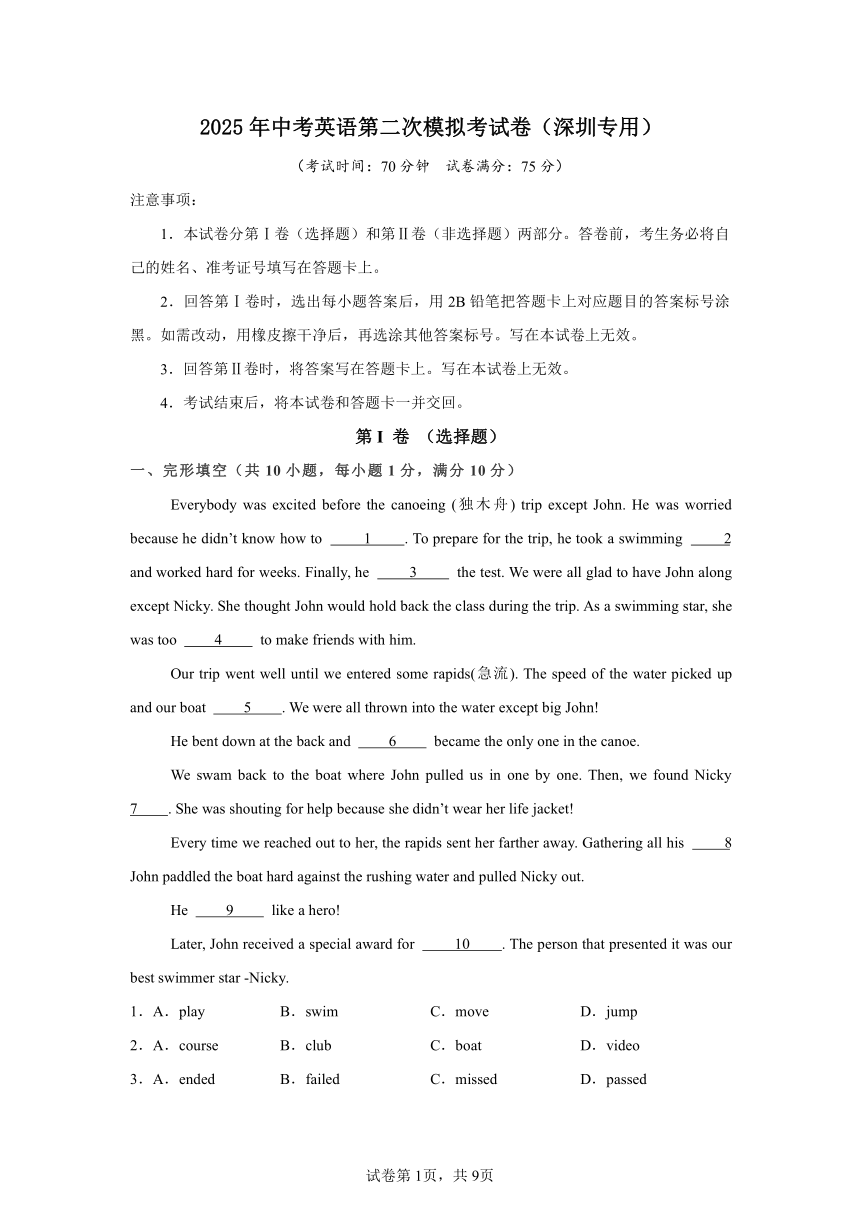
2025年中考英语第二次模拟考试卷(深圳专用) (考试时间:70分钟 试卷满分:75分) 注意事项: 1.本试卷分第Ⅰ卷(选择题)和第Ⅱ卷(非选择题)两部分。答卷前,考生务必将自己的姓名、准考证号填写在答题卡上。 2.回答第Ⅰ卷时,选出每小题答案后,用2B铅笔把答题卡上对应题目的答案标号涂黑。如需改动,用橡皮擦干净后,再选涂其他答案标号。写在本试卷上无效。 3.回答第Ⅱ卷时,将答案写在答题卡上。写在本试卷上无效。 4.考试结束后,将本试卷和答题卡一并交回。 第I 卷 (选择题) 一、完形填空(共10小题,每小题1分,满分10分) Everybody was excited before the canoeing (独木舟) trip except John. He was worried because he didn’t know how to 1 . To prepare for the trip, he took a swimming 2 and worked hard for weeks. Finally, he 3 the test. We were all glad to have John along except Nicky. She thought John would hold back the class during the trip. As a swimming star, she was too 4 to make friends with him. Our trip went well until we entered some rapids(急流). The speed of the water picked up and our boat 5 . We were all thrown into the water except big John! He bent down at the back and 6 became the only one in the canoe. We swam back to the boat where John pulled us in one by one. Then, we found Nicky 7 . She was shouting for help because she didn’t wear her life jacket! Every time we reached out to her, the rapids sent her farther away. Gathering all his 8 John paddled the boat hard against the rushing water and pulled Nicky out. He 9 like a hero! Later, John received a special award for 10 . The person that presented it was our best swimmer star -Nicky. 1.A.play B.swim C.move D.jump 2.A.course B.club C.boat D.video 3.A.ended B.failed C.missed D.passed 4.A.shy B.late C.proud D.mad 5.A.turned over B.sailed away C.set off D.went ahead 6.A.possibly B.truly C.luckily D.recently 7.A.in silence B.in danger C.in doubt D.in joy 8.A.strength B.knowledge C.support D.thought 9.A.fought B.waved C.shouted D.acted 10.A.honesty B.bravery C.wisdom D.confidence 二、阅读理解(共15小题,每小题2分,满分30分) Pacific pocket mouse is the smallest kind of mouse in North America. Pocket mice get their name from the special pouches (育儿袋) they have on their faces. These pouches are used by the mice to carry food and the material they need to make their homes underground. The mice are an important part of the environment because they help spread the seeds of the plants that grow naturally in this sandy area. Their digging underground also helps the plants grow. But starting in the early 1930s, humans began taking up more and more of the area where the mice usually lived. Pacific pocket mice began disappearing. By the 1970s, scientists believed that the Pacific pocket mouse had died out. But in 1994, scientists found some small groups of Pacific pocket mice. These groups were a long way away from each other, and were often separated by things like roads and buildings. Starting in 2012, the San Diego Zoo Wildlife Alliance (SDZWA) began working to ... ...
~~ 您好,已阅读到文档的结尾了 ~~

